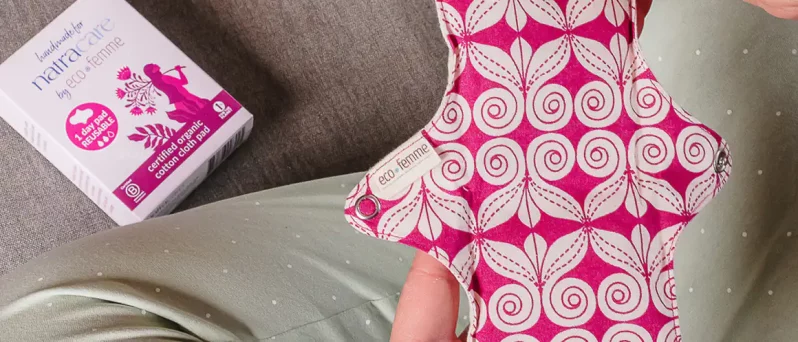Many people with periods use their monthly flow to keep tabs on their health. Whether you track your moods and regularity in a period tracker or look at what your period blood might be telling you, your period probably helps you to keep on top of what’s ‘normal’ for you. But did you know that your discharge can also help you to keep an eye on what’s going on with your body throughout your whole cycle? Here’s what different types of discharge might be telling you:
Discharge colour meaning
Discharge is most commonly recognised for being white or transparent, but it can actually be a whole range of colours, with different meanings related to each. Take a look at what your discharge colour might be telling you.
Clear to white
Normal discharge
Clear or white discharge is often seen as a healthy colour. (Depending on the texture and smell of the discharge) It can be a sign that everything is working as it should be.
Ovulation
Clear and stretchy discharge can be a sign of fertility or that you are currently ovulating. This might be useful to know if you’re trying to get pregnant, or if you’re trying to keep a better track of your cycle and its phases.
Pink or red to brown
Menstruation
If you’re due on your period or it’s just ended, your discharge could appear brown or bloody due to menstrual blood. Some people may also experience some spotting after ovulation, which can appear as bloody discharge. This is completely normal and nothing to worry about.
Tears
If you experience pink or red discharge after sex, it could be a sign of vaginal tears or irritation. You might notice this if you’ve had noticeably rough sex or feel some discomfort, too.
Infection or irritation
Red or pink discharge can also be a sign of some vaginal irritation or infections like a cervical infection. If you experience itching or discomfort with pink or red discharge, we recommend you see a doctor.
Cervical or endometrial cancer
In rare circumstances, pink vaginal discharge when you’re not on your period can be a sign of cervical or endometrial cancer. In this case, you should get it checked out by your healthcare provider.
Yellow or green
Healthy discharge
Yellow discharge that has only a very slight hue might not indicate any problems. If this comes around the same time as a change in your diet, the yellow colour could be down to this.
Infection
Yellow or green discharge with a smell or texture that isn’t normal for your body might indicate a bacterial or sexually transmitted infection. We recommend talking to a doctor if your discharge is yellow or green, with a thicker texture than usual and a foul smell.
Grey
Bacterial Vaginosis
Grey discharge can be a symptom of bacterial vaginosis (BV) – a common bacterial infection that can cause other symptoms like itching and a strong, sometimes fishy smelling discharge. If you think you might have BV, you should see a doctor for treatment.
Discharge consistency and texture meaning
Similar to the colour of your discharge, the texture can also vary – telling you a lot about what’s going on with your body.
Watery
Increased oestrogen levels
Oestrogen can promote fluid production, which means that when you have higher levels of oestrogen, you might experience more watery discharge. This is nothing to worry about and is completely normal.
Arousal
Similarly, when you’re aroused, blood rushes to your vagina which also promotes fluid production. In turn this can make your discharge watery in texture.
Sticky or stretchy
Ovulation
If your discharge is sticky, stretchy, and clear or white, it’s often a sign that you are ovulating. This can sometimes look like egg whites.
Thick, creamy, or clumpy
Yeast infection
Thick, white discharge with no odour at the beginning and end of your cycle is normal. If this comes with any itching, inflammation, or unusual smell it could be an infection. If the texture is clumpy, similar to cottage cheese, it could be a yeast infection and it’s a good idea to check with your doctor.
Infection
Yellow or green discharge that is thick or clumpy can be a sign of sexually transmitted infection. Foul smells are another potential sign of infection. If this is the combined colour and texture or smell of your discharge, you should see a healthcare professional.
Frothy
Trichomoniasis
If your discharge is frothy and yellow or green in colour it can be an indicator of trichomoniasis – a sexually transmitted infection that’s caused by a small parasite. Trichomoniasis can be treated with antibiotics, so see a doctor if you think you might have symptoms.
When to see your doctor
Keeping track of what’s regular for your own body is the best way to tell when something isn’t quite right – and this extends to your discharge. Generally speaking, if your discharge feels, looks, or smells out of the ordinary, or has any of the following warning signs, it’s a good idea to check in with your doctor:
- A significant change in texture or colour of discharge
- Vaginal itching or discomfort
- A strong smelling discharge – including fishy or metallic smells
- Frothy discharge
- Yellow-green or grey discharge
The most important thing is that you know what’s normal for yourself, because all bodies are different, and that you feel comfortable and confident. Panty liners can be a good option to help you feel dry and keep your underwear clean from discharge throughout your cycle.
And breathe...
Natracare panty liners are breathable, made with certified organic cotton, and absolutely no plastic! Perfect for everyday use.














Reading your information about issues there’s so much I ever knew wish I knew of this natracare newsletter / products before it great to learn this it’s never too late
I have never had my period and I’m 12 years old. Today I had a lot of brown discharge on my underwear and in my down there was some stretchy brown discharge stuff. Is there something wrong?
Hi Atlanta, this sounds like it could be the start of your period. It can take a long time for your menstrual cycle to become what will be a more normal period for you. First periods can be a very small amount of blood (which can look brown sometimes) and not last very long. If you’re still feeling worried or unsure, do talk to a trusted adult or healthcare provider.
Thank you for the really interesting and informative read. It’s really interesting to read about the different ways our discharge can tell things about our bodies.